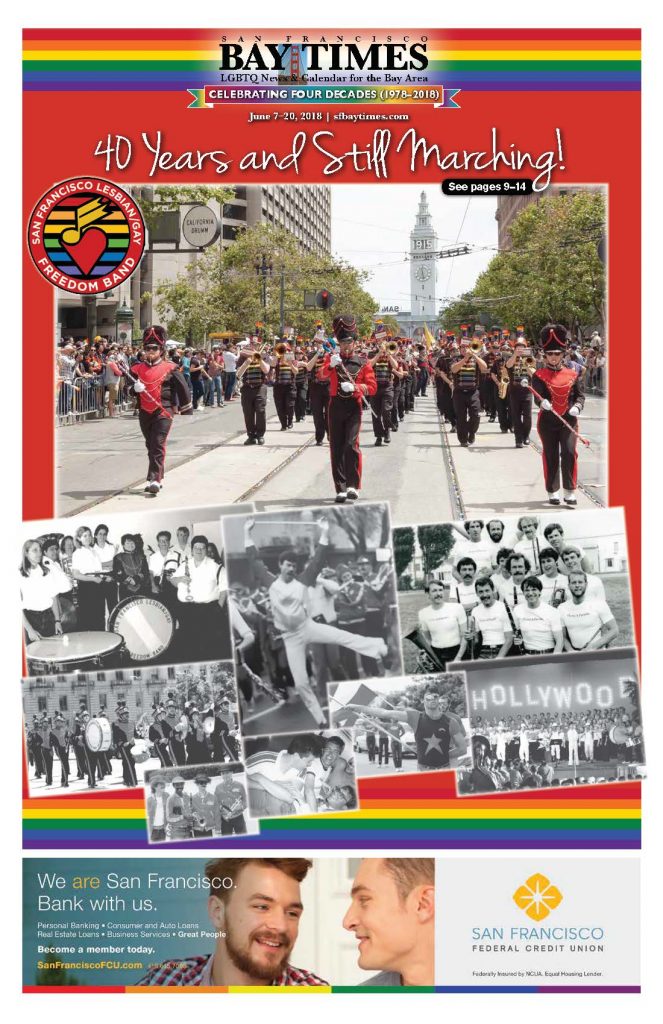
The San Francisco Lesbian/Gay Freedom Band (SFLGFB), like the San Francisco Bay Times, began in 1978, although the Band had a different name then: the San Francisco Gay Freedom Day Marching Band and Twirling Corps. To mark the shared 40th anniversary, we are presenting a special section that looks at both the Band’s pioneering past and its current status as one of the nation’s premier community-based concert and marching bands.
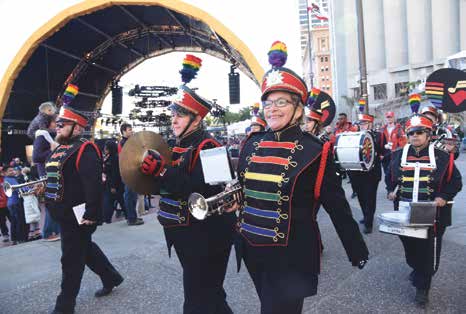
The coverage includes a personal remembrance of Jon Reed Sims (1947–1984) by his sister Judy Sims Billings. Sims was the visionary founder of SFLGFB, the first openly gay musical group ever to be formed in the world. Sims in 1978 also founded the San Francisco Gay Men’s Chorus, the first openly gay American choral group, which made its unplanned debut on November 27 that same year on the steps of San Francisco City Hall. It was at an impromptu memorial for Harvey Milk and Mayor George Moscone, who had both been assassinated earlier in the day. Sims additionally founded the Lesbian/Gay Chorus of San Francisco, Lambda Pro Musica orchestra (now defunct) and encouraged the formation of other bands in New York and Los Angeles.
Sims in 1978 further founded the Jon Sims Center for the Performing Arts, which until its closure in 2006 provided performance and rehearsal spaces for artists, as well as funding for at least one artist-in-residence annually.
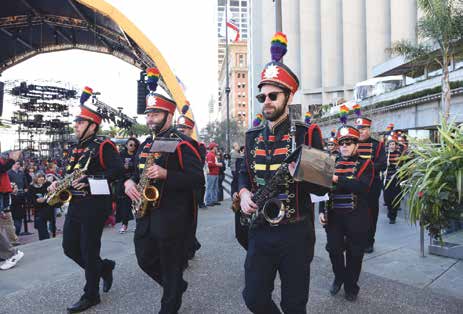
Although Sims died of HIV/AIDS on July 16, 1984—just six months after his January diagnosis—the legacy resulting from his tireless, groundbreaking efforts lives on. The SFLGFB has helped to carry us through some of our community’s darkest and most joyous moments over the past four decades. The artistic director baton has passed to numerous talented musicians, with Pete Nowlen serving in that key role since 2013. Our thanks go to him, as well as to Billings, Doug Litwin, Heidi Beeler, Kate Foust, Julie Williamson and to the many others who contributed not only to this keepsake section, but also to the music that continues to uplift and inspire those of us who, as was said of Sims, “march to a different drummer.”
 By Doug Litwin
By Doug Litwin
After 40 years, the San Francisco Lesbian/Gay Freedom Band (SFLGFB) has certainly earned the right to be called “The Official Band of San Francisco.” Hardly a major event goes by in town where these “Ambassadors of Joy” don’t perform.
What you may not know is that members of the Band have performed in many high-visibility events across the nation and internationally. In other words, the reach of this high-caliber musical ensemble is on a global scale. Here are some highlights of those performances:
Four Presidential Inaugurals
It all started in November 1992 at the annual “Creating Change” conference in Los Angeles, put on by the National LGBTQ Task Force. A few leaders of the Lesbian and Gay Bands of America (LGBA, now the Lesbian and Gay Band Association) attended this event just a week after Bill Clinton’s election. The positive energy led to the idea that an LGBT band should perform at the 1993 inauguration.
Following a flurry of activity—including applications, videos and obtaining support from politicians from across the country—on December 15, the invitation for LGBA to perform at President Clinton’s inauguration was received. That led a month-long sprint to register musicians, select artistic leadership, book flights, block hotel rooms and more. The massed band, including many from San Francisco, was stationed along the route of the inaugural parade and performed as thousands waited in the cold for the presidential motorcade to pass by. Without a doubt, the highlight was when the Clintons (Bill and Hillary) and the Gores (Al and Tipper) exited their limousine to enjoy the last part of the parade on foot. As they passed by the band playing “America The Beautiful,” they all waved and Bill Clinton gave us two presidential thumbs-up.
Four years later, LGBA again performed at the second Clinton Inauguration, this time stationed at an even more visible location along the parade route.
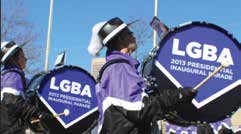 In 2008, hope was renewed with the election of Barack Obama. Again, LGBA and many San Franciscans were there, this time with the bar set even higher. The goal this time was to get selected to march in the inauguration parade itself. The effort was herculean, but it paid off in mid-December when word was received that this group would be the first gay organization to march in an inauguration parade. San Francisco’s own Kim Boyd was one of the proud drum majors.
In 2008, hope was renewed with the election of Barack Obama. Again, LGBA and many San Franciscans were there, this time with the bar set even higher. The goal this time was to get selected to march in the inauguration parade itself. The effort was herculean, but it paid off in mid-December when word was received that this group would be the first gay organization to march in an inauguration parade. San Francisco’s own Kim Boyd was one of the proud drum majors.
Upon Obama’s re-election in 2012, LGBA again applied to march in the inauguration parade. Based on the impressive track record from three previous events, LGBA was chosen for a repeat appearance. LGBA was one of only 56 bands selected from across the country to march in the 2013 parade, and 215 performers proudly marched past the presidential viewing platform. Check out many videos on YouTube (search for “LGBA inauguration”) and you’ll even find the audition video submitted with the 2013 application.
Ten Gay Games
At the Gay Games I Opening Ceremony on August 28, 1982, the SFLGFB and the Great American Yankee Freedom Band of Los Angeles both performed. The national group LGBA formed a month later in Chicago with the SFLGFB as a charter member.
Every four years since 1982, the Gay Games has taken place, and members of the San Francisco Band have performed with the massed band in concert, parade and pep settings. This has taken these musicians to Canada, the Netherlands, Australia and Germany. In just two months, these musicians will arrive in Paris to perform at Gay Games 10. Pete Nowlen, SFLGFB Artistic Director, will conduct two of the concerts there. Even before the trip to Paris takes place, plans are already coming to bring great music to Hong Kong during Gay Games 11 taking place for the first time in Asia in 2022.
Three Marches on Washington
Among the most meaningful events for the San Francisco musicians have been the three major national Marches on Washington in 1987, 2003 and 2010.
In 1987, the March was preceded by a sold-out concert called “Let Freedom Ring” staged at DAR Constitution Hall. Taking place in the midst of the AIDS crisis, the concert started out late because the ushers provided by the venue decided to wear rubber gloves when taking tickets from concert-goers. 750,000 people joined in this march the next day.
In 1993, the March on Washington was again preceded by a major concert called “Americans We” at the Warner Theatre. An estimated 1,000,000 joined in this march.
The Millennium March of 2000 brought another 1,000,000 people to the streets of Washington. In addition to the March itself, there was a marriage ceremony at the Lincoln Memorial, where several LGBA members got married. The massed band provided live music on the main stage throughout the afternoon. They performed alongside speakers Ellen Degeneres, Martina Navratilova, Judith Light, Melissa Etheridge, RuPaul, Madonna, Ian McKellen and Eartha Kitt.
As you can see, the legendary presence and music of the SFLGFB has spread far beyond the Bay Area.
Doug Litwin is the Board President of the San Francisco Lesbian/Gay Freedom Band.
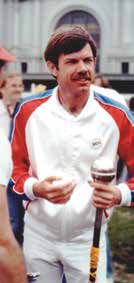 By Judith Sims Billings
By Judith Sims Billings
A Literal and Figurative Middle America Upbringing
To say that Jon Sims came from the center of the country would be an understatement. When Jon was born, we lived on a farm a few miles from Lebanon, Kansas, about 5 miles from the geographic center of the U.S. As we grew up, we were each other’s playmates as we lived on farms without close neighbors.
In 1951, we moved to a farm closer to Smith Center, Kansas, and closer to my paternal grandparents. We had electricity in the house for the first time. About this time, I began taking piano lessons, but I did not like practicing. Jon, however, was very interested in the piano. When he was about 6, he began taking piano lessons. Within a year, Jon had surpassed me in his ability to play. Jon was a natural born musician.
There was no kindergarten in rural schools; at 6, Jon began first grade at Dewey one room. There were three students in his class throughout grade school. Jon completed eight grades at Dewey, as had our father and paternal grandmother.
As we reached age 8, we both joined 4-H. We had 4-H projects involving cattle, cooking, sewing, and Jon even had pigs one year. When we named our 4-H animals, Jon named his for music and composers. His heifer was named Nola. When she had a male calf a couple of years later, Jon named him Felix, for Felix Arndt the composer of “Nola.” Jon also did cooking and sewing projects in 4-H.
The fact that he was practically the only male in the county who took sewing and cooking in 4-H didn’t seem to bother Jon, and Mother just acted like it was the most normal thing. Our parents encouraged us to do anything we wanted to, seeing no real boundaries. Jon won first place at the Kansas State Fair for his sugar cookies. One year, we made identical dresses for our younger cousins. At first the 4-H judge thought she was judging the same dress twice, but then she said, “The hem in this one isn’t as good as the first one.” Jon’s dress got a better ribbon than mine.
Nurturing an Aptitude for Music
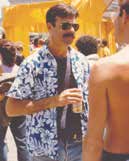 Jon continued to excel in music. At about 12 he said to Mother, “I just want to play a rag before I die.” With Mother’s encouragement, Jon began playing rags. He liked Scott Joplin’s works, especially the “Maple Leaf Rag.” Jon would perform at small events in our rural community including playing piano background music Saturday nights in a restaurant, which was a very unusual occurrence for Smith Center. As Jon’s abilities grew, it was hard to find piano teachers to challenge him. When I was able to drive, and Jon was 12, we’d spend Saturday mornings together, as I drove him about 30 miles to study with a more advanced piano teacher.
Jon continued to excel in music. At about 12 he said to Mother, “I just want to play a rag before I die.” With Mother’s encouragement, Jon began playing rags. He liked Scott Joplin’s works, especially the “Maple Leaf Rag.” Jon would perform at small events in our rural community including playing piano background music Saturday nights in a restaurant, which was a very unusual occurrence for Smith Center. As Jon’s abilities grew, it was hard to find piano teachers to challenge him. When I was able to drive, and Jon was 12, we’d spend Saturday mornings together, as I drove him about 30 miles to study with a more advanced piano teacher.
When Jon entered Smith Center High School, he wanted to be in band and started playing the cornet. The students who went to school in town began playing musical instruments in sixth grade, but in a country school we did not have this opportunity. Jon continued to excel in music and soon caught up and surpassed the abilities of his classmates. When he was a sophomore, they needed a tuba player in the band, so Jon began playing tuba. The music instructor realized Jon could play just about any instrument they needed. In his junior year, they needed someone to play the French horn, and Jon met his calling. That same year, Jon became the drum major for the high school marching band.
During high school, Mother said that Jon was loved by all of the older women in town. Jon was kind and considerate of everyone and always spoke to, and helped, these older women he’d met through our grandmothers. This was the same generation of women who taught him to knit and crochet when he was in grade school.
Jon attended Fort Hays State University (FHSU) in Hays, Kansas. He became the drum major for the all men’s Marching 100. A good friend from high school and FHSU said, “Jon played horn in the wonderful Brass Choir directed by Leland Bartholomew. Jon was highly respected by the faculty and students alike. What a wonderful musician and friend.” At Hays, Jon developed a life-long respect, admiration, and relationship with Ruth Oag, a visiting piano professor from Australia. Jon visited Miss Oag, in Australia, on his trip around the world in 1982.
In his junior year, Jon moved to Wichita State University to find a program to meet his needs to study French horn and composition. He was a very flamboyant drum major at both universities. Following graduation from Wichita State, Jon enrolled in graduate school at Indiana University with the goal of studying French horn under Philip Farkas. Jon flourished under Dr. Farkas’ tutelage.
Move to San Francisco
Upon graduation from Indiana University, Jon moved to Chicago to teach music at the Junior High level. He was frustrated with teaching from the beginning. Jon wanted students to be as focused and dedicated to music as he was, and that was not the case. He’d say, “How can you bring a child to a music lesson at 7:30 am and forget the musical instrument?” He felt junior high students should just be focusing on learning music and not trying to march and play music, but marching was the show piece that the parents and community wanted to see. After 3–4 years in Chicago, Jon followed a friend to San Francisco. Jon taught school in Daly City before starting the Band.
In June of 1978, I had been at a nursing convention in Honolulu, and made a stopover in San Francisco to visit Jon. On Sunday, we went to Golden Gate Park. I sat under a tree while the developing band—The Gay Freedom Day Marching Band and Twirling Corp—practiced marching and marching while playing instruments. The first performance of the Band occurred a few days later.
It was a time of Anita Bryant and much prejudice towards the community. Jon told me that he was not interested in making a political statement; he just wanted to get people together to have fun making music. In November 1980, my husband Jerry and I attended the Band’s concert at Davies Symphony Hall. It was a beautiful concert and quite formal, as I remember wearing a long, formal dress to the concert.
We were always very proud of Jon and his abilities, but none of us realized the impact he would have. I continue to be amazed and proud of the impact of his vision.
Coming Out
I don’t remember Jon every telling me he was gay. I had figured it out about 1973, and at some point, we just began talking about it. He did not come out to the family until after our mother died in 1975. We are not sure if she knew, but Mother always said, “Jon marches to a different drummer.”
Sometime after that, he came to Smith Center and talked to our father and our grandparents and other family about it. In 1975–1976, being gay was not something readily accepted in small town America, or in many other venues. Our maternal grandmother explained it to our cousin, “Now Jon is gay and what that means is that he is just like the boys who decide to become priests.” I think some of the family were concerned this might harm their social standing, but in general, the family just let it go, and didn’t say much about it.
In our part of the country, no one really talked about being gay in the mid-1970s.
Judith Sims Billings is the sister of the late Jon Sims, founder of the San Francisco Lesbian/Gay Freedom Band and the San Francisco Gay Men’s Chorus.
Recent Comments